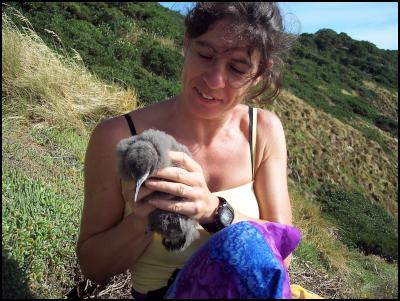Mana Island seabird colonisation plot thickens

Click for big version
DOC fauna biodiversity technical support officer Lynn Adams with one of the 40 fluttering shearwater chicks transferred to Mana Island yesterday. Photo: Richard Gill/DOC.
16 January 2006
Mana Island seabird colonisation plot thickens
A plot to trick seabirds into believing Mana Island is “home” intensified this weekend with the transfer of a third seabird species to the island.
Forty fluttering shearwater chicks from Long Island in the Marlborough Sounds followed diving petrel and fairy prion onto the island as part of a plan by the Department of Conservation and Friends of Mana Island (FOMI) to restore its ecology.
Diving petrels transferred to the island during 1997–99 have begun breeding there, and fairy prions transferred during 2002-2004 are starting to return. They also originated from colonies in the Marlborough Sounds.
Using the same methods applied to the diving petrel and prion transfers, the fluttering shearwaters were captured as fully grown chicks and flown by helicopter to Mana Island yesterday. They have been placed into artificial burrows and will be fed sardine smoothies by a team of volunteers until they fledge, over the following two to three weeks.
This is the second ever transfer of fluttering shearwaters to an offshore island. A colony was also successfully re-established on Maud Island in the Marlborough Sounds, DOC Kapiti Area manager Ian Cooksley said.
“We are confident that the birds will also colonise Mana Island.”
The project is being funded by Friends of Mana Island through grants and donations, with support from Te Atiawa and Ngati Toa.
“We are very appreciative of the support we have received from sponsors and the local community,” Friends president Brian Paget said.
The Mana Community Trust, the Kapiti branch of Forest and Bird and FOMI members are among the project sponsors.
If the first transfer of fluttering shearwater to Mana Island succeeds, up to 200 more birds will be taken there over the following two to three years.
Mana MP and Minister for the Community and Voluntary Sector Luamanuvao Winnie Laban said it was important to acknowledge the voluntary support behind this project and “the people who have worked hard to preserve these birds for future generations”.
“The release of these beautiful birds will enhance the Mana region and provide an opportunity for all New Zealanders to celebrate our unique wildlife."
The sound system on the island that plays fluttering shearwater, fairy prion and diving petrel calls will continue to help lure birds to Mana Island, and a new sound system being built there will focus on fluttering shearwaters.
The first birds should start returning to the island in 2008 and are expected to start breeding there in 2011.
The fluttering shearwater is a gull-sized brown and white seabird that is common around New Zealand coastal waters and often in Wellington harbour. Its main breeding areas are on islands off the coast of Northland, in the Bay of Plenty, and in the outer Marlborough Sounds.
Their bones, along with those of diving petrels and fairy prions, have been found in middens on Mana Island.
“It is highly likely, therefore, that there were colonies of these species on the island before they were eradicated by 500 years of human habitation and farming,” Ian Cooksley said.
The seabird transfers are part of a larger restoration programme for the island, which has also seen the introduction of takahe, North Island robin, brown teal, diving petrels, fairy prion, yellow-crowned kakariki, speckled and spotted skinks, Wellington green geckos and flax weevils. A wetland has been restored and hundreds of thousands of native trees have been planted by volunteers.
Burrowing seabirds are "keystone" species for island ecosystems. Their burrows create safe, sheltered and humid homes for lizards, tuatara and insects. Because they feed at sea and nest in dense colonies, they create highly fertile ecosystems by delivering nutrients in the form of droppings, spilt regurgitations, addled eggs and corpses.
ENDS


 Bill Bennett: Download Weekly - 100% claim lands One New Zealand in criminal court action
Bill Bennett: Download Weekly - 100% claim lands One New Zealand in criminal court action FSCL: Woman Scammed Out Of $25,000 After Job Offer On LinkedIn
FSCL: Woman Scammed Out Of $25,000 After Job Offer On LinkedIn NIWA: Cheers To Crustaceans - New Species Named After Welly Brewery
NIWA: Cheers To Crustaceans - New Species Named After Welly Brewery MBIE: Trans-Tasman Earth Observation Research Studies Confirmed
MBIE: Trans-Tasman Earth Observation Research Studies Confirmed NZ Association of Scientists: Royal Society Te Apārangi Governance Submissions Close - NZAS Submission
NZ Association of Scientists: Royal Society Te Apārangi Governance Submissions Close - NZAS Submission HortPlus: Project Aims To Improve Quality Of Weather Data In New Zealand
HortPlus: Project Aims To Improve Quality Of Weather Data In New Zealand



